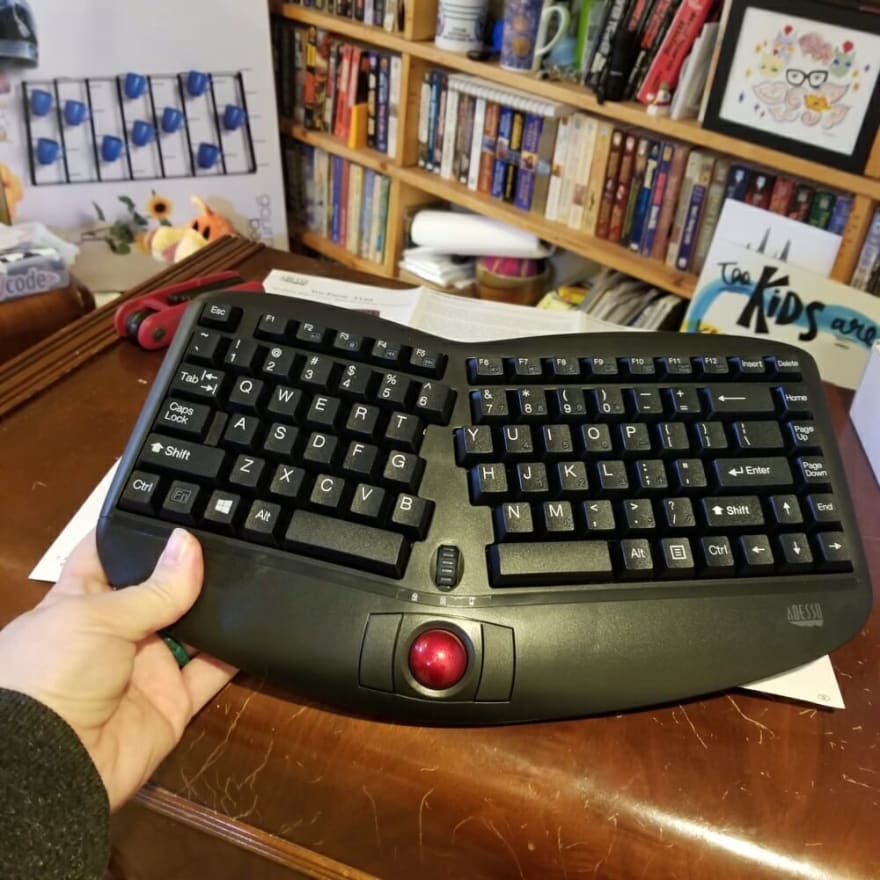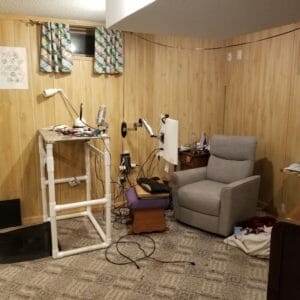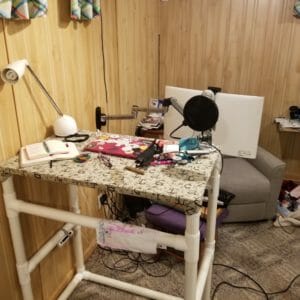I don’t have hEDS. But I don’t not have it, if you see what I mean. My ligaments have the approximate tensile strength of that one sketchy rubber band you find in the bottom of the junk drawer. When I was a teenager, I once dislocated my kneecap while stretching. When I was 22, I spent months on disability because of a mousing-induced shoulder injury. What I’m saying is I’m maybe not a perfect genetic specimen.
I’m thinking about this tonight because I was trying to clean my keyboard, and I may have wrecked it instead, and I’m extremely particular about my keyboards. Which led me to thinking about how many ergonomic/accessibility changes I’ve made over my career. Each one is totally reasonable and logical in isolation, but then I try to explain to someone why my workspace the way it is, and it just seems like injury stories all the way down.
When I started college at 17, my mom had already had carpal tunnel surgery on both hands. As part of my exciting new college life, I also decided to teach myself to type with the Dvorak keyboard layout, instead of QWERTY, because it involves less hand motion. (The actual studies on this are complicated and contentious, but it’s certainly what I thought then, and retraining a touch-typist to former speeds is merely tedious, not hard)

I got through college without significant hand and wrist problems, although another kneecap dislocation ended my college volleyball career before it even started.
But then I got the job that crippled me.
I was working for a smallish company, doing a bunch of PDF document production. I was seated in a sort of atrium, and there was a constant cold draft. And I was moving my hand from the keyboard to the mouse and back about every 5-10 seconds. The consequences were not immediate, but they last to this day, and they made me think I’d lost my career just as it was starting. Did you know, that if you have reasonably strong muscles, they can knot up so badly that they dislocate your rib from the spine? Yeah, neither did I. Nor several doctors I saw. It was a long journey to figure out what was happening and how to treat it, mostly.
That’s when I started showing up to jobs with my own keyboard. You look like a dork when you do this, but I didn’t care. Adesso made an ergonomically-curved keyboard that had a centered touchpad, so I never had to move my arm. I’ve bought …. 6 of them? The oldest had PS2 plugs, and the newest a wireless USB dongle. Some people show up to new jobs with favorite coffee mugs, I have a keyboard.

That helped a lot, but it’s not perfect. I got tendonitis in my right wrist, and ended up needing surgery after months of splinting and PT. My left elbow was next, months of PT and cortisone and I still have to be nice to it. I sprained my ankle so badly I was on crutches for weeks. Right this minute, I’m wearing a wrist brace because the laxity in my wrist caused my forearm to tighten up, which gave me tendonitis in my right elbow.
So when I started looking to replace my keyboard, I knew that I wanted the split keyboard with a trackball or touchpad in the center. Most of the cute custom ones won’t work because I sit in a glider rocker to work, with my keyboard in my lap. That’s the most neutral position for my hands and shoulders and elbows and wrists. I’m not wild about how poorly the wireless receiver worked for me, and kinda want to go back to a direct connection. Lossy typing makes me hysterical pretty rapidly. My feet are up on a gliding footstool, because rocking while I write helps me think, so foot controls are out.
For so long, my serious writing and typing has happened at home, so it hadn’t occurred to me how funny my workstation seems to people who are used to putting their macbook on a desk and sitting in an office chair.



Hopefully, tomorrow I will get up and my keyboard will be healed! And if it isn’t, I can go back to one of the older ones, which I keep around because I’m that intense about not using a mouse. But in the meantime, I’m going to go window-shopping, because there are a lot more keyboard nerds than there were when I started this journey, and some of them have some pretty cool ideas.
Advice? Of course I have advice.
- Try not to piss off your body in the first place. Keep it strong and limber.
- A good physical therapist or occupational therapist is probably better trained in body mechanics than many doctors, even the orthopedists. Ask your friends for references.
- Keep doing your PT. For the rest of your life. Mind you, if I did all of mine, it would be about 3 hours a day, but you figure out ways to work it in. I did ankle strengthening standing on one leg in scrum meetings.
- Listen to your body. Really listen. Lots of things that aren’t ergonomic best practice may be best practice for you. Or things that you “should” do may be physically uncomfortable. Like “type with both your feet flat on the floor”. (This is me laughing in ADHD/hypermobile bisexual)
- No laptop is designed for long-term work, by the constraints of being a laptop. It’s not a keyboard for typing, it’s for looking things up quickly. Please don’t spend all your time typing on it.
In the US, we’re probably looking at working from home for at least another 6 months, unless a lot of things change. So if you have an office job, it’s time to treat home like an office. If you have to work at the kitchen table, can you get a better chair? Can you invest in a real keyboard? Can you mount a monitor on the wall over the table? If you have an office space, make sure you’re not looking down at your monitor, reaching with your arms, or hunching your back when you fit into your furniture.
And on the topic of RSIs and accessibility, let me recommend Josh Comeau’s great post on using voice dictation and eye tracking to code hands-free. If you are able-bodied, remember that’s a temporary condition.
Stay home if you can, stay as safe as possible, remember that good ergonomics are an investment in both your happiness and your health.


Top comments (0)